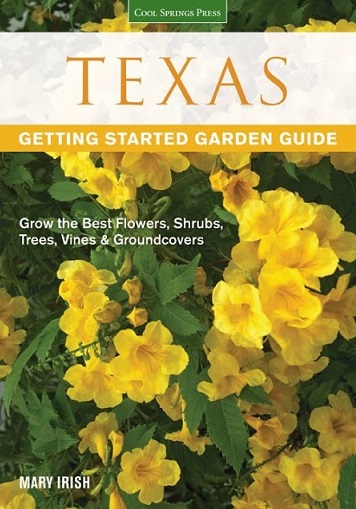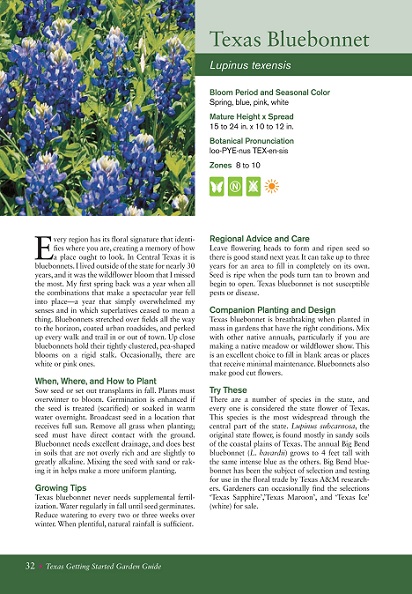Read This: Texas Getting Started Garden Guide

So when a book about Texas gardening appears, I jump on it, although not without some trepidation. After all, Texas is a huge state, almost 800 miles wide and encompassing four USDA climate zones, with desert, plains, subtropical, coastal, and woodland ecologies. On the eastern side of the state, Houston gets 50 inches of rain in an average year; on the western side, El Paso receives less than 8 inches. Soil is largely acidic to the east and alkaline to the west, which, combined with average rainfall, is a huge factor in what kinds of plants will thrive in your garden.
Mary Irish, author of Texas Getting Started Garden Guide: Grow the Best Flowers, Shrubs, Trees, Vines & Groundcovers (Cool Springs Press, 2013), recognizes “the presumption,” as she puts it, of covering all of Texas. Her solution is to profile only (or mostly) those plants that thrive throughout the state. I was dubious at first, expecting that I’d see a lot of generic plant picks of the sort found in Neil Sperry’s Complete Guide to Texas Gardening (whose general gardening info is, however, still helpful to a beginner) — serviceable but uninspired plants like holly, liriope, and juniper. Instead, I was pleased to detect a bias toward drought-tolerant and native plants that grow well in the central, southern, and western parts of the state. I don’t know how East Texas gardeners will view Irish’s plant picks. For my part, I rejoiced in their applicability to my underserved region.
After 25 years in Arizona, where she served as Director of Public Horticulture at Desert Botanical Garden, Irish returned to her home state of Texas in 2012 and now runs the plant sales program at San Antonio Botanical Garden. With a number of desert-gardening books to her name, Irish certainly knows and appreciates dry-climate plants. However, lest you worry that the book is all about agaves and prickly pears, let me assure you that those make up only a small portion of her plant profiles.

I do have a few quibbles. My eye was drawn to a number of typos, and I couldn’t help thinking that the book would have benefited from one more round of proofreading. For each plant profile, I would have liked a symbol indicating deer resistance, since that’s a big issue for many gardeners. Also, a map symbol to clearly indicate which part of Texas each plant is best suited to would have been helpful for new gardeners who aren’t as familiar with their soil types. Irish often includes such information in the text, but having it right at the top would have been nice. Finally, the title is a bit of a misnomer, as it’s not really a primer on how to garden in Texas. It’s primarily a plant guidebook for Texas gardeners, and an excellent one at that.
Aside from these small issues, I found this to be a very useful book, one that any Texas gardener will appreciate. You’ll want to add this one to your holiday wish list.
Disclosure: Cool Springs Press sent me a copy of Texas Getting Started Garden Guide for review. I reviewed it at my own discretion and without any compensation. This post, as with everything at Digging, is my own personal opinion.
All material © 2006-2013 by Pam Penick for Digging. Unauthorized reproduction prohibited.


California gardeners face many of the same issues with general garden books – our best gardening seasons are also spring and fall and this is also a big state (tho’ not as big as Texas!) with a wide range of climates. (And, no, contrary to popular opinion, we can’t grow everything!) I was curious and checked Cool Springs’ book list to see if they offered something similar for CA gardeners. There is a CA guide, labeled volume II although there appears to be no volume I – still, I may order it as, after all, I haven’t bought a new garden book in at least a month…
Good point about California gardening conditions, Kris, although I’m envious of your Sunset magazine and gardening-book series, which serve your region so well. I also like the way you think with regard to needing a new garden book at least once a month. 🙂 —Pam
I really enjoy your book reviews. As I am building my gardening library, I look to your blog for solid recommendations and critiques.
That’s so nice to hear, Marilyn. I hope you’ll come back after you read this book and share your own impression. —Pam